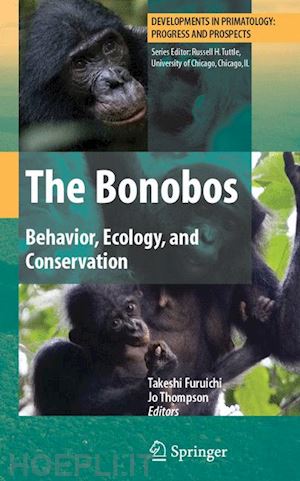
Questo prodotto usufruisce delle SPEDIZIONI GRATIS
selezionando l'opzione Corriere Veloce in fase di ordine.
Pagabile anche con Carta della cultura giovani e del merito, 18App Bonus Cultura e Carta del Docente
Among all great ape species, the bonobo is still the least studied in both captivity and the wild. Nevertheless we have observed a considerable increase in knowledge across various fields of bonobo research in recent years. In part due to the ongoing peace process in the Democratic Republic of Congo, research and conservation activities on the bonobo have resumed and multiplied since 2001.
Part One of The Bonobos: Behavior, Ecology, and Conservation focuses on scientific research. Behavioral studies in captivity propose to answer why bonobos have some unique characteristics such as high social status of females and flexible social relationships. The outcomes present important aspects to be investigated in running field studies. In the wild, analysis of population genetics across the bonobo's distribution range illuminates the species' evolutionary path and contributes to a global management plan. Site specific analysis reveals how genetics are used to re-identify individuals after an extended interruption of long-term research. Ecological studies at three independent sites, two in Salonga National Park, as well as one in the Luo Scientific Reserve, provide valuable information for the comprehension of ecological adaptation of bonobos. With the application of recent methods of mammalian feeding ecology as well as comparative approaches in other great ape species, these studies allow us to draw conclusions on ape ecological adaptation and evolution.
Part Two of The Bonobos: Behavior, Ecology, and Conservation focuses on conservation. In overview, local and global aspects of the factors threatening the wild bonobo population are reviewed. Here the outcomes of large-scale efforts within the functioning ecosystem conservation paradigm focus on three landscapes within the range of the bonobo: the Salonga-Lukenie-Sankuru Landscape, the Maringa-Lopori-Wamba Landscape, and the Lac Télé-Lac Tumba Swamp Forest Landscape, are presented. Papers in thispart include the different aspects of various stakeholders and discuss the unique threats and actions taken to ensure bonobo survival. Pioneering the way, details from the first comprehensive assessment of bonobos in the Salonga National Park reveal a baseline from which to monitor future trends. Concerned about the indigenous' peoples aspects of conservation, an ethnographic study documents cultural, social, and economic practices for the purpose of reviving the local traditional knowledge to exemplify possible applications at the national level. To be inclusive of all aspects of range country concerns, the contributions of Kinshasa's bonobo sanctuary to national conservation efforts are presented. The outcome of these contributions taken together not only illuminate the current status of the bonobo but allow for critically designing the next steps for the continuation of its future.











Il sito utilizza cookie ed altri strumenti di tracciamento che raccolgono informazioni dal dispositivo dell’utente. Oltre ai cookie tecnici ed analitici aggregati, strettamente necessari per il funzionamento di questo sito web, previo consenso dell’utente possono essere installati cookie di profilazione e marketing e cookie dei social media. Cliccando su “Accetto tutti i cookie” saranno attivate tutte le categorie di cookie. Per accettare solo deterninate categorie di cookie, cliccare invece su “Impostazioni cookie”. Chiudendo il banner o continuando a navigare saranno installati solo cookie tecnici. Per maggiori dettagli, consultare la Cookie Policy.